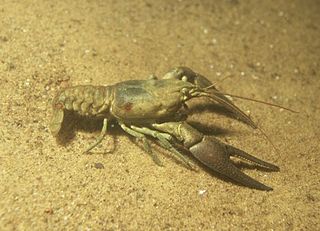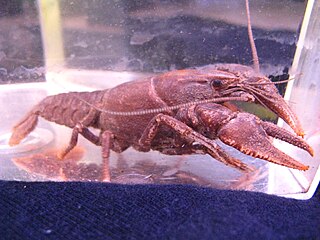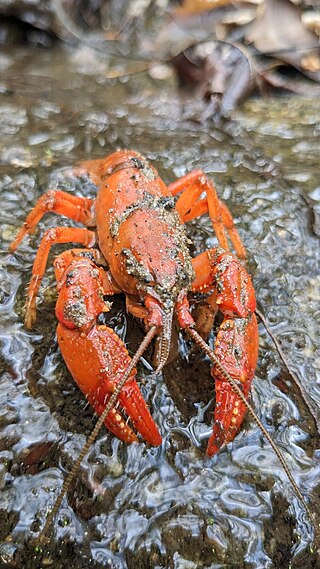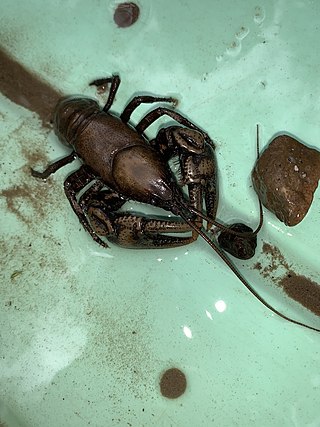
Cambarus is a large and diverse genus of crayfish from the United States and Canada. The adults range in size from about 5 cm (2.0 in) up to approximately 15 cm (5.9 in).

Cambarellus is a genus of small freshwater crayfish in the family Cambaridae. The 19 species are found in Mexico and the Gulf States of the United States. Among the Mexican species, C. areolatus, C. patzcuarensis, and C. prolixus are considered seriously threatened by the IUCN, and C. alvarezi is already extinct. C. chihuahuae was also believed to be extinct until rediscovered in 2012. C. alvarezi and four undescribed, extinct Cambarellus species were restricted to desert spring systems in southwestern Nuevo León; each one shared its habitat with a Cyprinodon pupfish.

Cambarus aculabrum is a rare species of cave-dwelling crayfish known by the common name Benton county cave crayfish. It is native to Arkansas in the United States, where it is known from only four locations. It is a federally listed endangered species of the United States.
Cambarus catagius, the Greensboro burrowing crayfish, is a species of crayfish in the family Cambaridae. It is found only in a limited area of North Carolina, where it is considered a species of special conservation concern.
Cambarus chaugaensis, the Chauga crayfish or Chauga River crayfish, is a species of crayfish in the family Cambaridae. It is endemic to the Carolinas in the United States of America. The common and scientific names refer to the Chauga River of South Carolina, where the first specimens were collected.
Cambarus coosawattae, the Coosawattae crayfish, is a species of crayfish in the family Cambaridae. It is endemic to Georgia. The common name refers to the Coosawattee River, with the original specimens being collected in the Cartecay River which combines with another river to form the Coosawattee.

Cambarus fasciatus, the Etowah crayfish, is a species of crayfish in the family Cambaridae. This species is endemic to Georgia, where it is state listed as S2.

Cambarus georgiae, the Little Tennessee crayfish, is a species of crayfish in the family Cambaridae. It is found in Georgia and North Carolina.
Cambarus reburrus, the French Broad crayfish, is a species of crayfish in the family Cambaridae. It is endemic to North Carolina.
Cambarus speciosus, the beautiful crayfish, is a species of crayfish in the family Cambaridae. It is endemic to Georgia.
Cambarus truncatus, the Oconee burrowing crayfish, is a species of crayfish in the family Cambaridae. It is found in North America.
The Guyandotte River crayfish is a species of crayfish found in a small stream system in Wyoming County, West Virginia, US. They are closely related to the Big Sandy crayfish, and until recently, the two were thought to belong to the same species. The Guyandotte River crayfish is currently listed as Data Deficient by the IUCN and was listed under the Endangered Species Act with the Big Sandy crayfish on April 4, 2016.

Procambarus is a genus of crayfish in the family Cambaridae, all native to North and Central America. It includes a number of troglobitic species, and the marbled crayfish (marmorkrebs), which is parthenogenetic. Originally described as a subgenus for four species, it now contains around 161 species.

The Big Sandy crayfish, Cambarus callainus, are freshwater crustaceans of the family Cambaridae. They are found in the streams and rivers of Appalachia in Virginia, West Virginia, and Kentucky, in what is known as the Big Sandy watershed. Populations are often mistaken with Cambarus veteranus, but morphological and genetic data suggest that these are separate taxa; however, both are protected under the Endangered Species Act. There is very little information available on the Big Sandy crayfish because it is a relatively new species.
Faxonius maletae, sometimes called the Kisatchie painted crayfish or Kisatchie painted crawfish, is a species of crawdad in the Cambaridae family. The specific epithet maletae is in honor of the discoverer's wife, author Maleta M. Walls, who helped collect many of the original specimens. It was originally described as a subspecies of Orconectes difficilis, but later elevated to full species status. The common name refers to the Kisatchie National Forest, near where the original specimens were found in Bayou Santabarb.

Cambarus asperimanus, the mitten crayfish, is a species of crayfish in the family Cambaridae. It is found in North America.

Cambarus davidi, also known as the Carolina ladle crayfish, is a species of crayfish in the family Cambaridae. It is endemic to central North Carolina, where it is restricted to the upper Neuse and Cape Fear river basins.

Faxonius is a genus of freshwater crayfish in the family Cambaridae. There are more than 90 described species in Faxonius. It includes the rusty crayfish, an invasive species in North America, and three species, F. virilis, F. immunis, and F. limosus, that are invasive to Europe.

Cambarus carinirostris, the rock crayfish, is a species of crayfish in the family Cambaridae. It is found in the mid-Atlantic region of the United States.
Cambarus gentryi, the linear cobalt crayfish, is a small species of burrowing crayfish. One of 115 species in the genus Cambarus, it is notable for its deep blue carapace. It is endemic to Tennessee in the United States.












